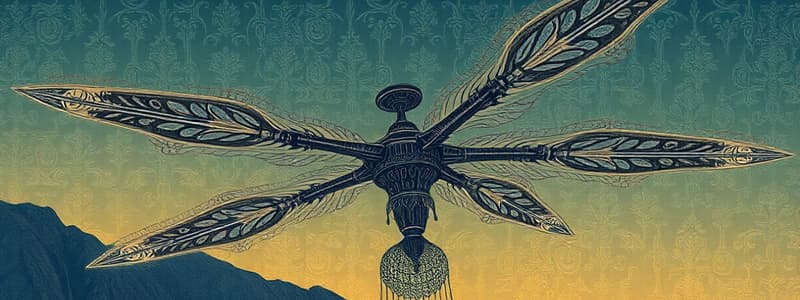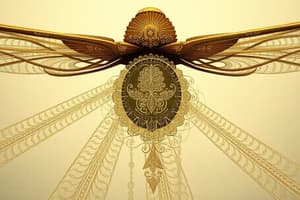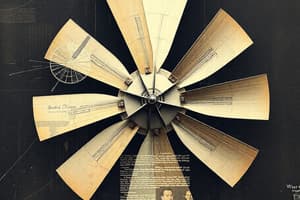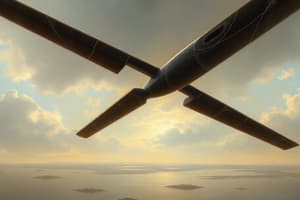Podcast
Questions and Answers
What is the difference between Symmetrical and Asymmetrical blades?
What is the difference between Symmetrical and Asymmetrical blades?
- Symmetrical blades have identical upper and lower surfaces, while Asymmetrical blades have a higher camber on the upper surface and a flatter lower surface.
- Symmetrical blades are designed for higher lift, while Asymmetrical blades are designed for better aerodynamic pitching characteristics.
- Symmetrical blades are more common in manufacturing, while Asymmetrical blades are less common due to their unstable aerodynamic characteristics.
- All of the above. (correct)
Which type of blade has better aerodynamic pitching characteristics?
Which type of blade has better aerodynamic pitching characteristics?
- Symmetrical (correct)
- Asymmetrical
Which type of blade produces more lift for the same surface area?
Which type of blade produces more lift for the same surface area?
- Symmetrical
- Asymmetrical (correct)
How do engineers achieve the same aerodynamic pitching characteristics from an Asymmetrical blade as a Symmetrical blade?
How do engineers achieve the same aerodynamic pitching characteristics from an Asymmetrical blade as a Symmetrical blade?
Which type of blade is more commonly used in helicopter rotor systems?
Which type of blade is more commonly used in helicopter rotor systems?
What are the two main types of planforms?
What are the two main types of planforms?
What is a Parallel/Uniform planform?
What is a Parallel/Uniform planform?
What is a Tapered planform?
What is a Tapered planform?
Which planform is preferred for manufacturing?
Which planform is preferred for manufacturing?
Why is manufacturing a Parallel/Uniform planform more cost-effective?
Why is manufacturing a Parallel/Uniform planform more cost-effective?
Out of the two planforms, which one produces lift more evenly without correction?
Out of the two planforms, which one produces lift more evenly without correction?
How do engineers compensate for the difference in lift production between the root and tip of a uniform planform blade?
How do engineers compensate for the difference in lift production between the root and tip of a uniform planform blade?
Which blade could generate greater lift if both have the same surface area?
Which blade could generate greater lift if both have the same surface area?
Tapered planform blades also face the same challenges as uniform planform blades where they produce unequal lift between the root and tip.
Tapered planform blades also face the same challenges as uniform planform blades where they produce unequal lift between the root and tip.
What feature is common to all leading edges of rotor blades, regardless of the material they are made from?
What feature is common to all leading edges of rotor blades, regardless of the material they are made from?
What causes erosion on the leading edge of rotor blades?
What causes erosion on the leading edge of rotor blades?
Why is the bottom of a rotor blade usually painted flat black?
Why is the bottom of a rotor blade usually painted flat black?
Which rotor blade type requires specific static discharge capabilities?
Which rotor blade type requires specific static discharge capabilities?
What feature is built into composite rotor blades to safely handle static discharge?
What feature is built into composite rotor blades to safely handle static discharge?
What materials are rotor blades typically manufactured from?
What materials are rotor blades typically manufactured from?
What is the primary inspection method for composite rotor blades?
What is the primary inspection method for composite rotor blades?
Why is bonded construction preferred for rotor blades?
Why is bonded construction preferred for rotor blades?
Out of single-pocket and multi-pocket designs, which is quicker and easier to manufacture?
Out of single-pocket and multi-pocket designs, which is quicker and easier to manufacture?
Flashcards
Symmetrical Rotor Blade
Symmetrical Rotor Blade
The upper and lower surfaces of the blade are identical.
Asymmetrical Rotor Blade
Asymmetrical Rotor Blade
The upper surface has a higher camber (curvature) than the lower surface, which is flatter.
Aerodynamic Pitching Characteristics
Aerodynamic Pitching Characteristics
Symmetrical blades have better aerodynamic pitching characteristics.
Lift Production
Lift Production
Signup and view all the flashcards
Trailing Edge Sweep
Trailing Edge Sweep
Signup and view all the flashcards
Common Rotor Blade Design
Common Rotor Blade Design
Signup and view all the flashcards
Asymmetrical Blade Stability
Asymmetrical Blade Stability
Signup and view all the flashcards
Parallel/Uniform Planform
Parallel/Uniform Planform
Signup and view all the flashcards
Tapered Planform
Tapered Planform
Signup and view all the flashcards
Preferred Planform
Preferred Planform
Signup and view all the flashcards
Even Lift Production
Even Lift Production
Signup and view all the flashcards
Unequal Lift Production (Uniform)
Unequal Lift Production (Uniform)
Signup and view all the flashcards
Negative Twist
Negative Twist
Signup and view all the flashcards
Twist Calculation
Twist Calculation
Signup and view all the flashcards
Equal Lift Production (Twist)
Equal Lift Production (Twist)
Signup and view all the flashcards
Lift Comparison (Area)
Lift Comparison (Area)
Signup and view all the flashcards
Equal Lift Production (Tapered)
Equal Lift Production (Tapered)
Signup and view all the flashcards
Leading Edge Protection
Leading Edge Protection
Signup and view all the flashcards
Blade Paint
Blade Paint
Signup and view all the flashcards
Static Discharge
Static Discharge
Signup and view all the flashcards
Bonding Strips
Bonding Strips
Signup and view all the flashcards
Rotor Blade Materials
Rotor Blade Materials
Signup and view all the flashcards
Rotor Blade Inspection
Rotor Blade Inspection
Signup and view all the flashcards
Bonded Construction
Bonded Construction
Signup and view all the flashcards
Single-Pocket Construction
Single-Pocket Construction
Signup and view all the flashcards
Multi-Pocket Construction
Multi-Pocket Construction
Signup and view all the flashcards
Spanwise Balance Weights
Spanwise Balance Weights
Signup and view all the flashcards
Chordwise Balance Weights
Chordwise Balance Weights
Signup and view all the flashcards
Tracking Balance Weights
Tracking Balance Weights
Signup and view all the flashcards
Movable Balance Weights
Movable Balance Weights
Signup and view all the flashcards
Trim Balance Weights
Trim Balance Weights
Signup and view all the flashcards
Trim Weight Effects
Trim Weight Effects
Signup and view all the flashcards
Trim Tabs
Trim Tabs
Signup and view all the flashcards
Trim Tab Function
Trim Tab Function
Signup and view all the flashcards
Trim Tab Effect
Trim Tab Effect
Signup and view all the flashcards
Pre-Rigging
Pre-Rigging
Signup and view all the flashcards
Rigging Sequence
Rigging Sequence
Signup and view all the flashcards
Auto-Throttle Rigging
Auto-Throttle Rigging
Signup and view all the flashcards
Rigging and Testing Sequence
Rigging and Testing Sequence
Signup and view all the flashcards
Rotor Blade Root
Rotor Blade Root
Signup and view all the flashcards
Rotor Blade Tip
Rotor Blade Tip
Signup and view all the flashcards
Leading Edge
Leading Edge
Signup and view all the flashcards
Trailing Edge
Trailing Edge
Signup and view all the flashcards
Servo Tabs
Servo Tabs
Signup and view all the flashcards
Servo Tab Benefits
Servo Tab Benefits
Signup and view all the flashcards
Additional Servo Tab Benefits
Additional Servo Tab Benefits
Signup and view all the flashcards
KMAX Collective
KMAX Collective
Signup and view all the flashcards
Study Notes
Rotor Blade Design
-
Symmetrical vs. Asymmetrical Blades:
- Symmetrical blades have identical upper and lower surfaces.
- Asymmetrical blades have a higher camber on one surface and a flatter surface on the other.
- Symmetrical blades have better aerodynamic pitching characteristics.
- Asymmetrical blades produce more lift for the same surface area when compared to symmetrical ones.
- Asymmetrical blades now use a 3-degree upward sweep on the trailing edge to achieve better pitching characteristics.
-
Blade Planforms:
- Parallel/Uniform: Leading and trailing edges run parallel and chord length is constant.
- Tapered: Leading and trailing edges converge towards the tip, and chord length decreases.
- Uniform planform is preferred due to better cost-effectiveness in manufacturing.
- Tapered planform achieves more even lift distribution across the blade without modifications, but needs adjustments when uniform chord blades are used
-
Aerodynamic Considerations:
- Twist: Negative twist in uniform planform blades (greater angle of attack at the root compared to the tip) compensates for differences in blade speed along its length.
- Lift variations: Tapered blades naturally cater to differences in speed along the blade since their differing chord lengths accommodate varying lift requirements at the root and tip.
-
Blade Material and Construction:
- Stainless steel capping protects leading edges to prevent erosion.
- Bottom of the blade is painted black for glare prevention by the pilot.
- Composite blades demand special static discharge capabilities with bonding strips.
- Blade construction methods:
- Bonded: Stronger and more reliable; no weakening through drilling.
- Multi-pocket: Easier repair but more costly to build.
- Single pocket: Fast and inexpensive to build but costly to repair when damaged. Single-pocket is scrapped if damaged.
- Additional doubler plates are often used at the root for structural support.
Rotor Blade Balance Weights
- Types:
- Spanwise (tip)
- Chordwise (leading edge, roughly 30-50% from leading edge)
- Tracking (leading and trailing edges at tip further increasing/decreasing height)
- Placement:
- The placement of each type of balance weight is dictated by the manufacturer and impacts the tracking of the blade and needs for aerodynamic control systems.
- Movement:
- Chordwise balance weights typically cannot be moved.
- Trim Tabs:
- Located at the 75% span of the trailing edge.
- Control blade track by altering the air pressures.
Additional Rigging and Performance
- Rigging System Priority: Collective is usually rigged first (potentially with the throttle).
- Post-Rigging Procedures: Ground testing, hovering, full flight tests, and autorotation checks are performed.
- Servo Tabs: These tab systems reduce the need for hydraulic power by using trailing edge tabs and linkages.
- Benefits of Servo Tabs: Extended operational lifespan; simpler hub design; reduced vibration; reduced noise.
Studying That Suits You
Use AI to generate personalized quizzes and flashcards to suit your learning preferences.




